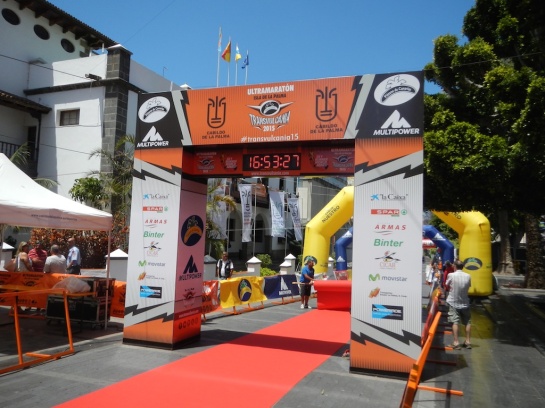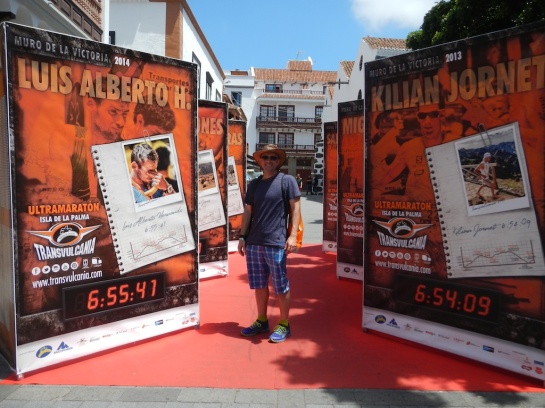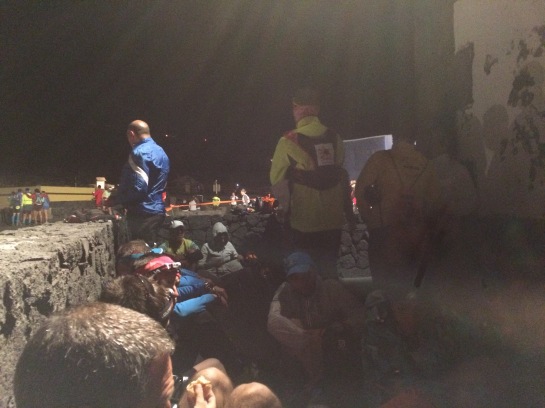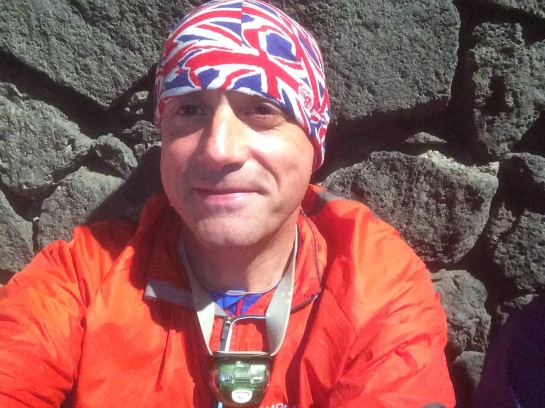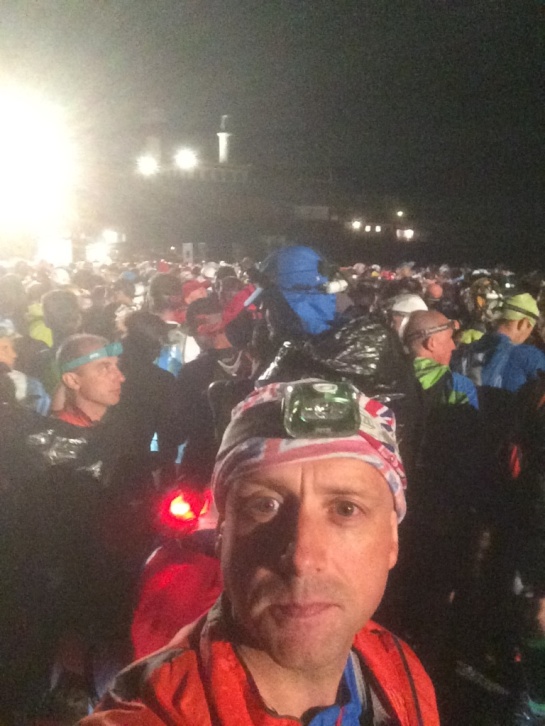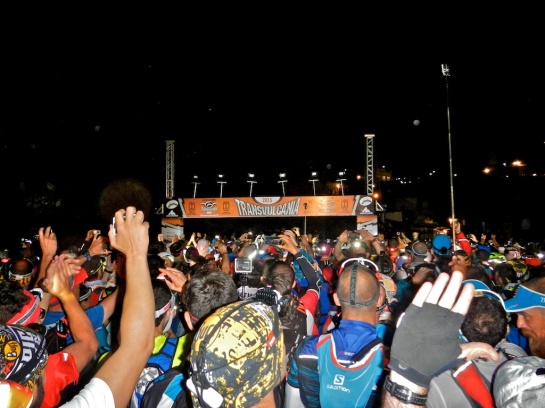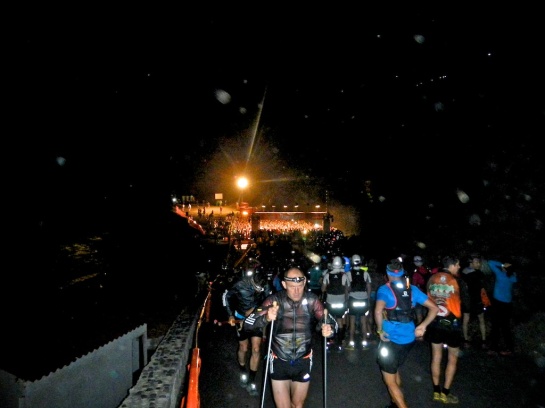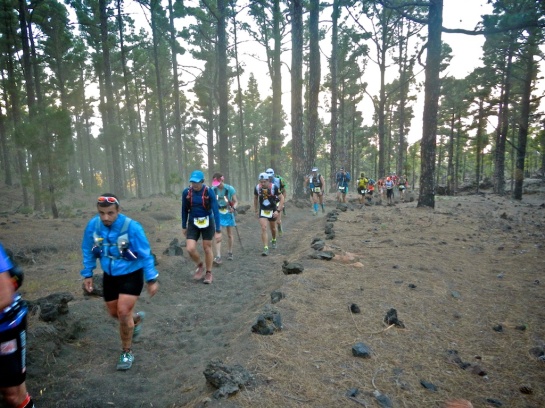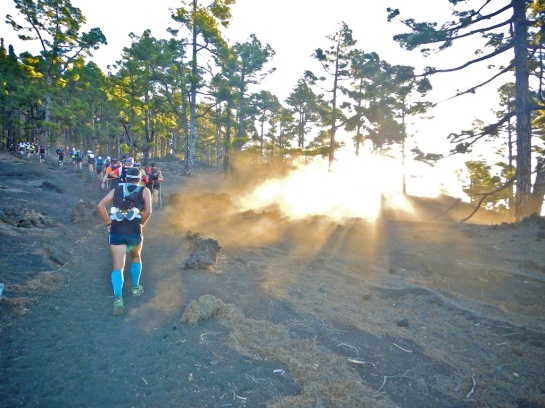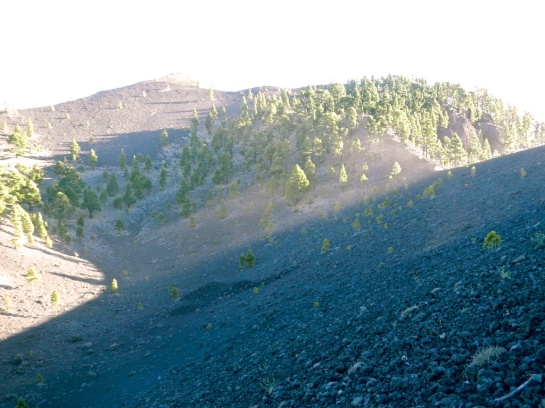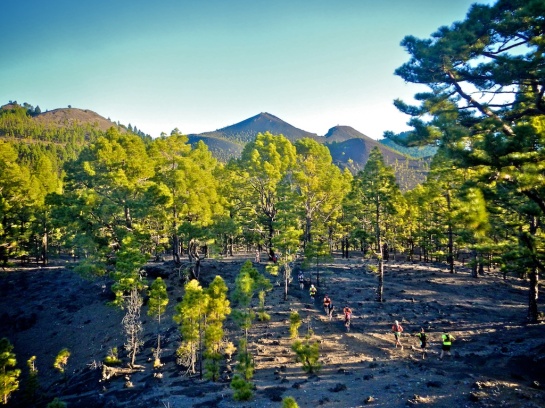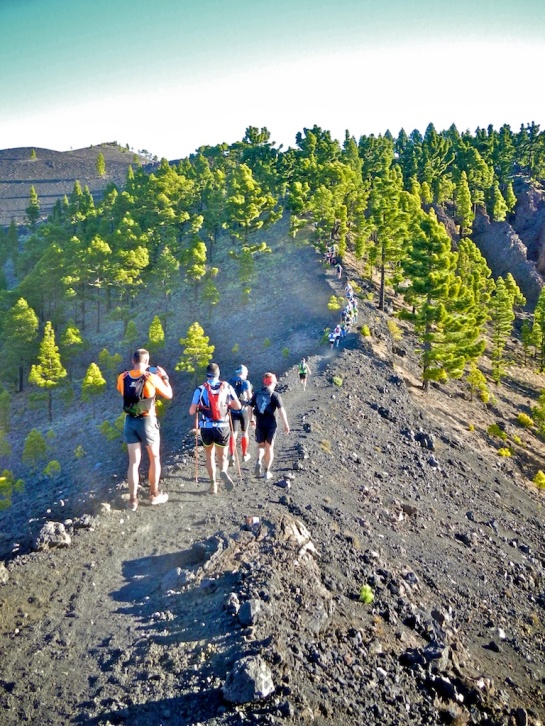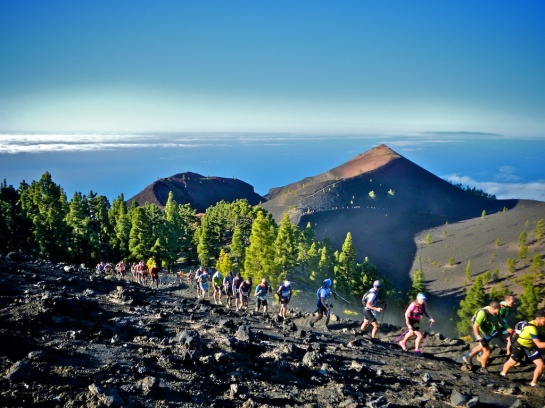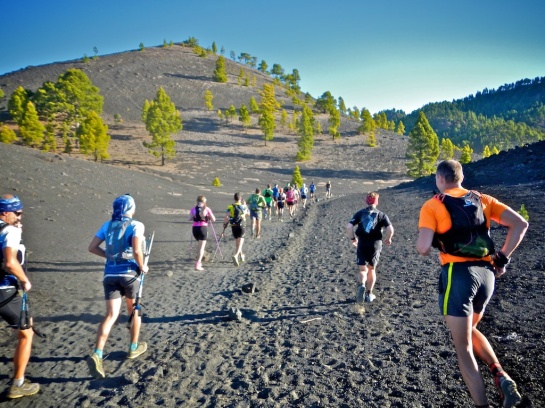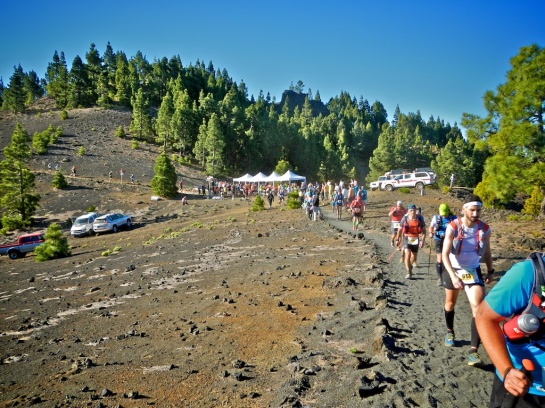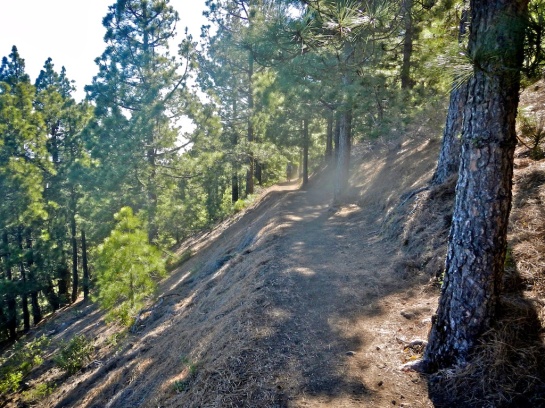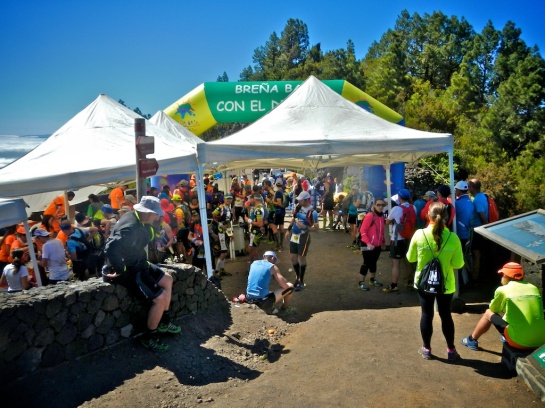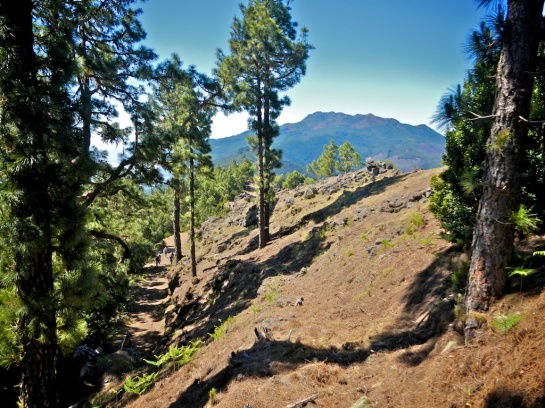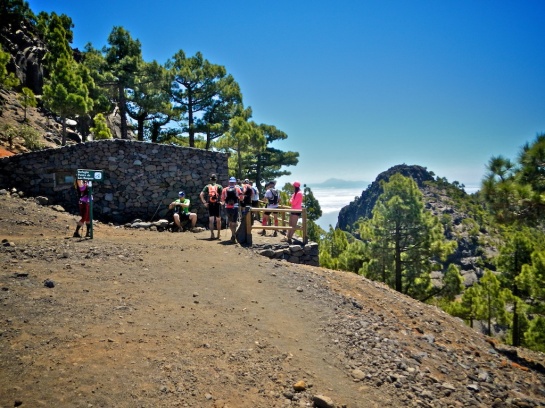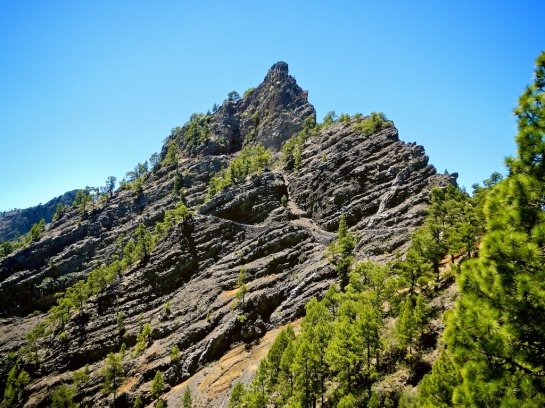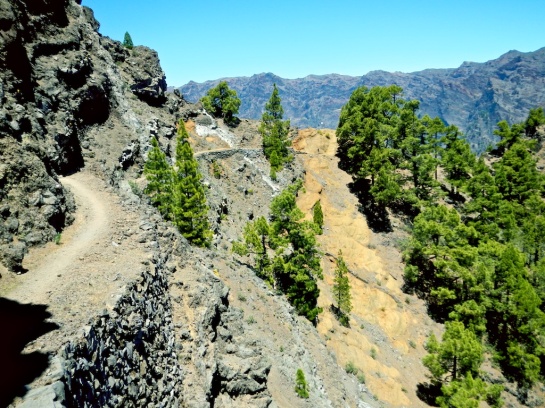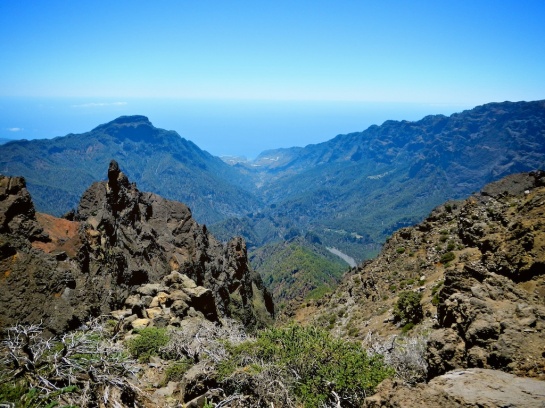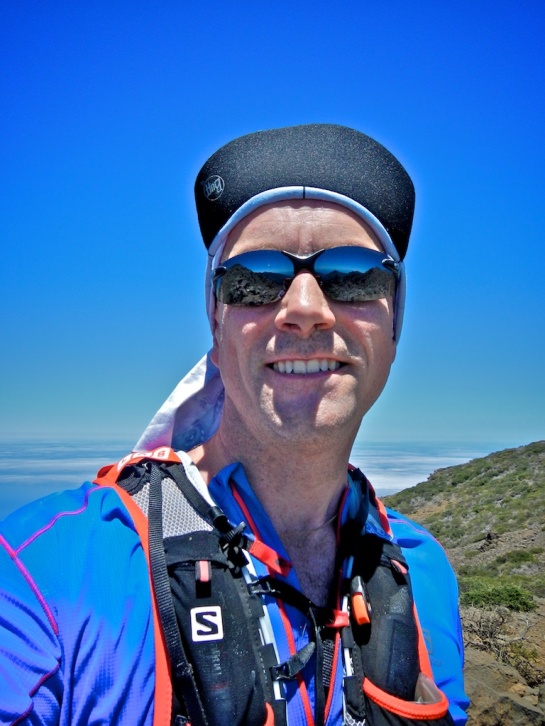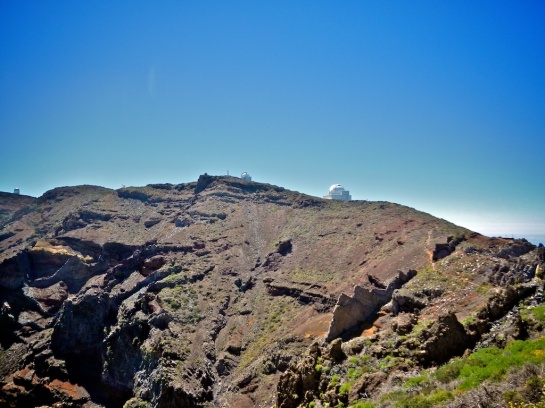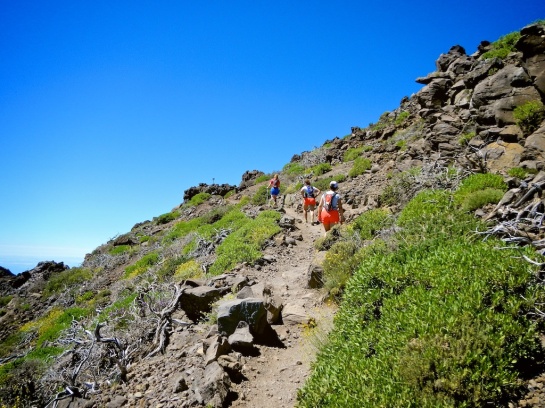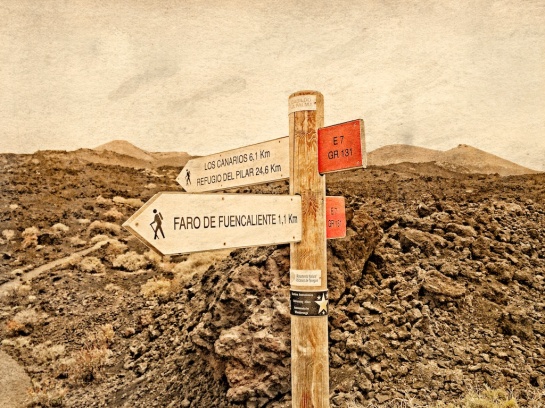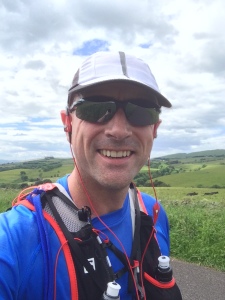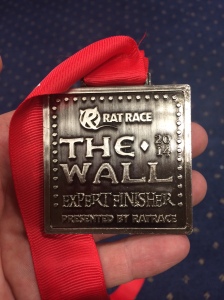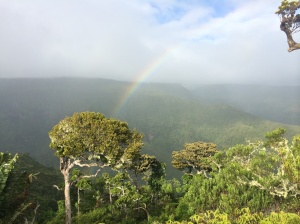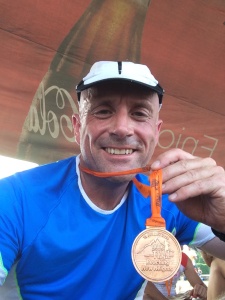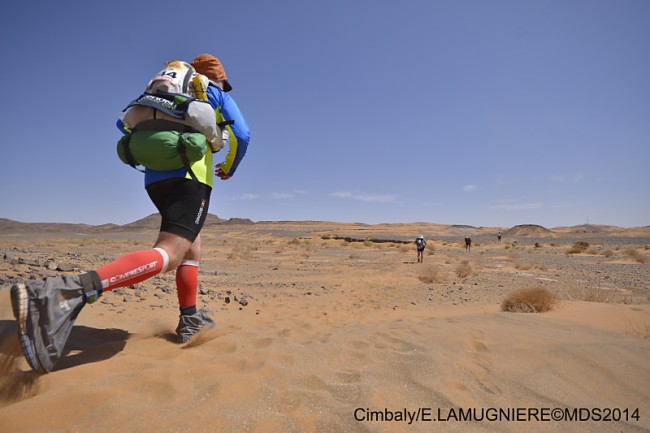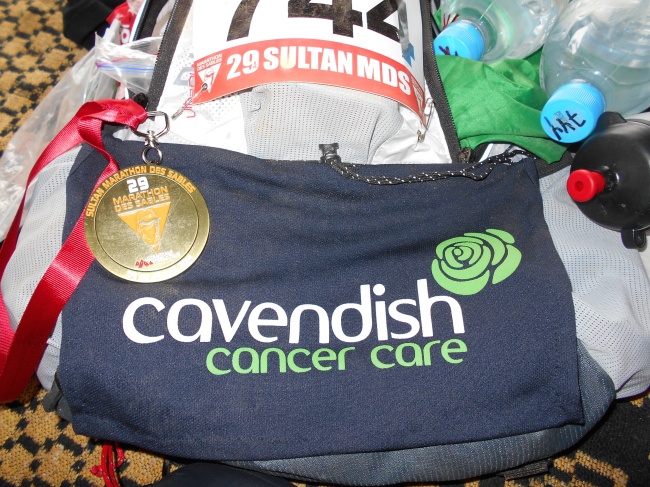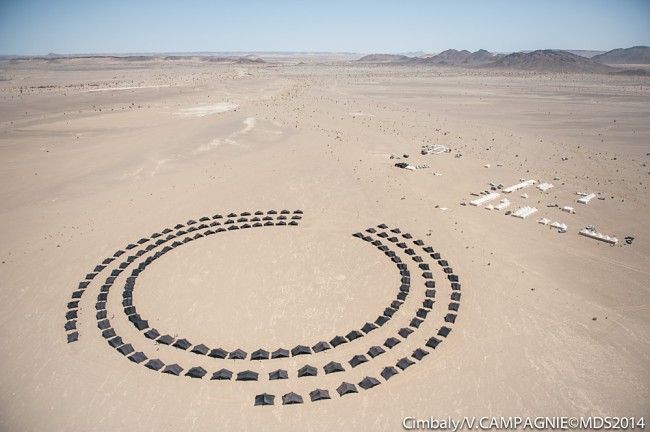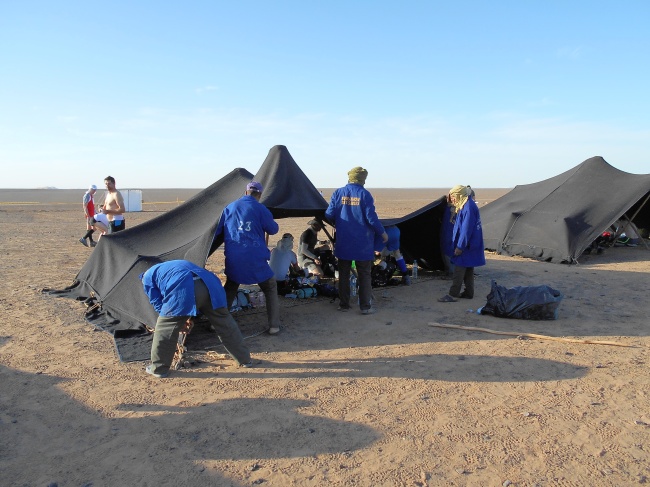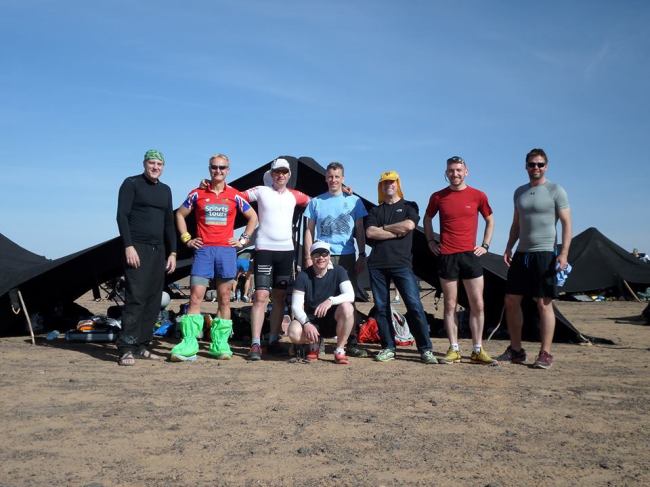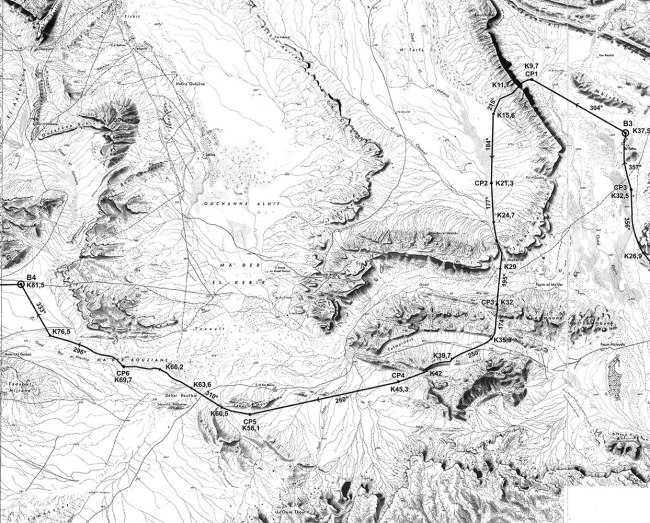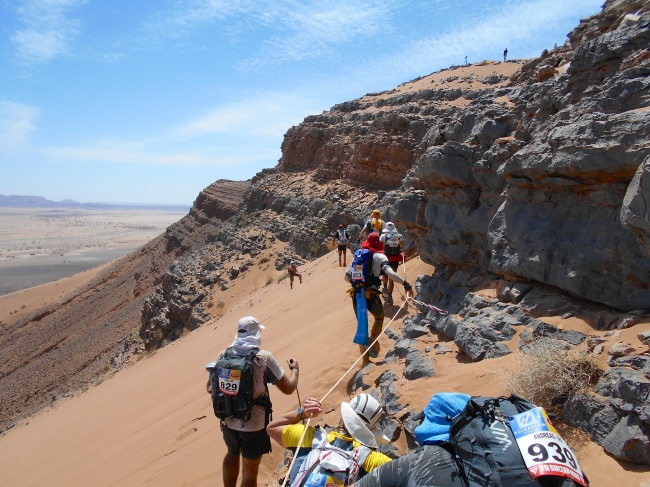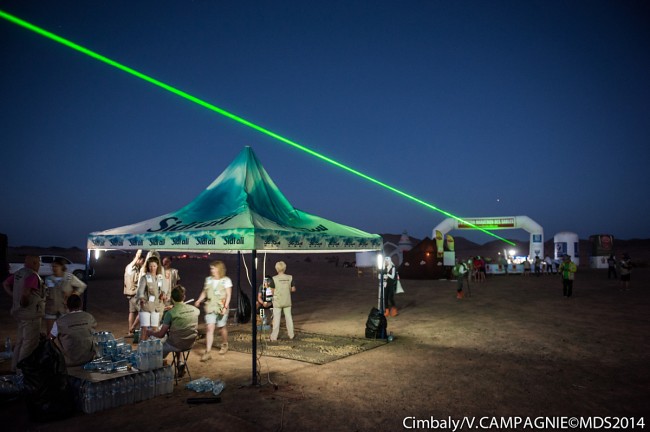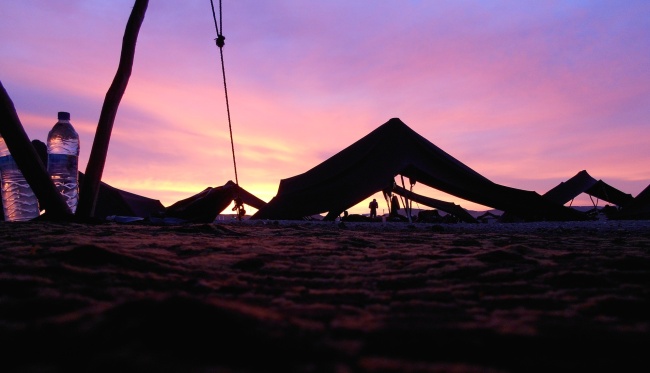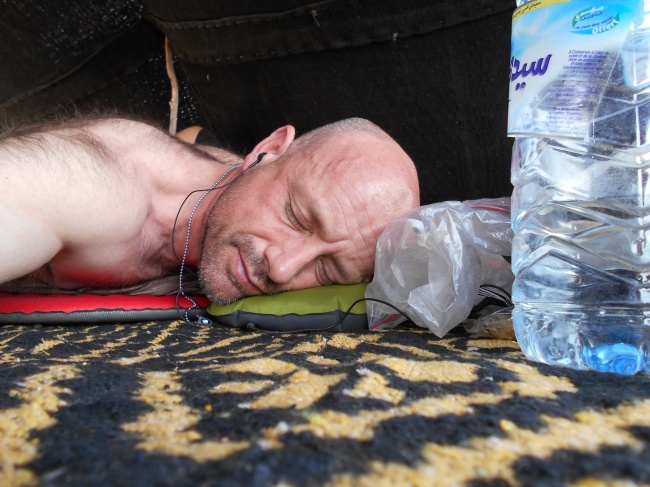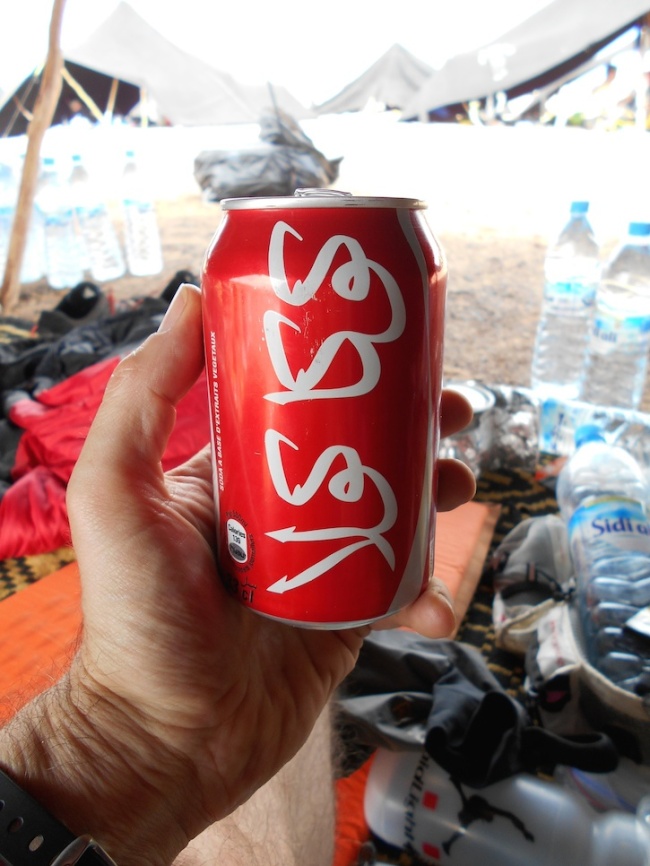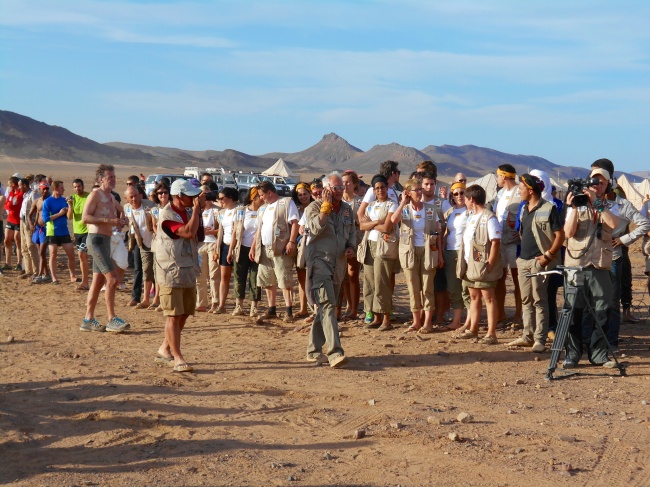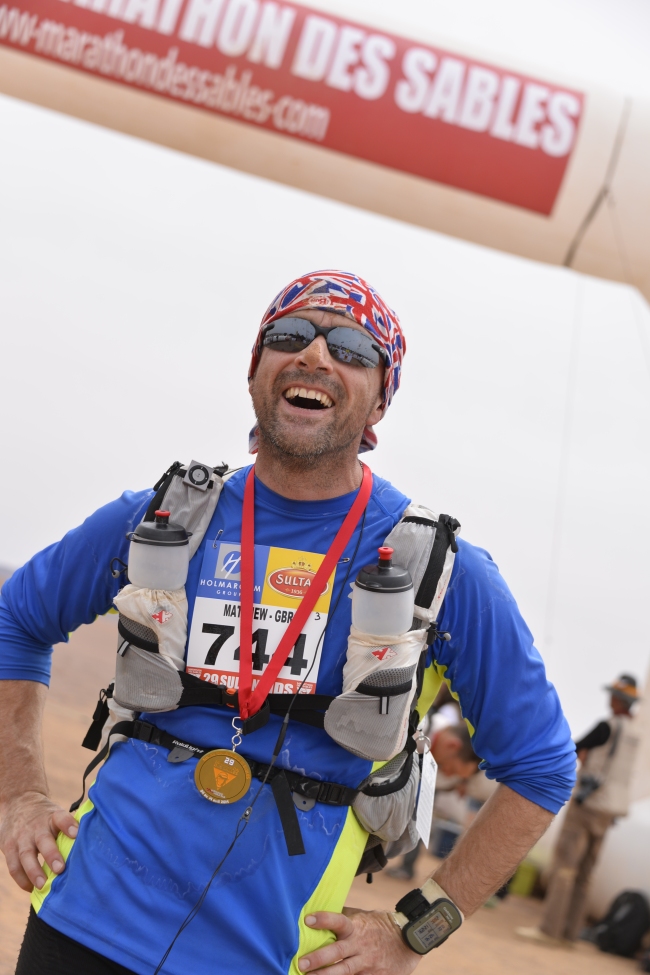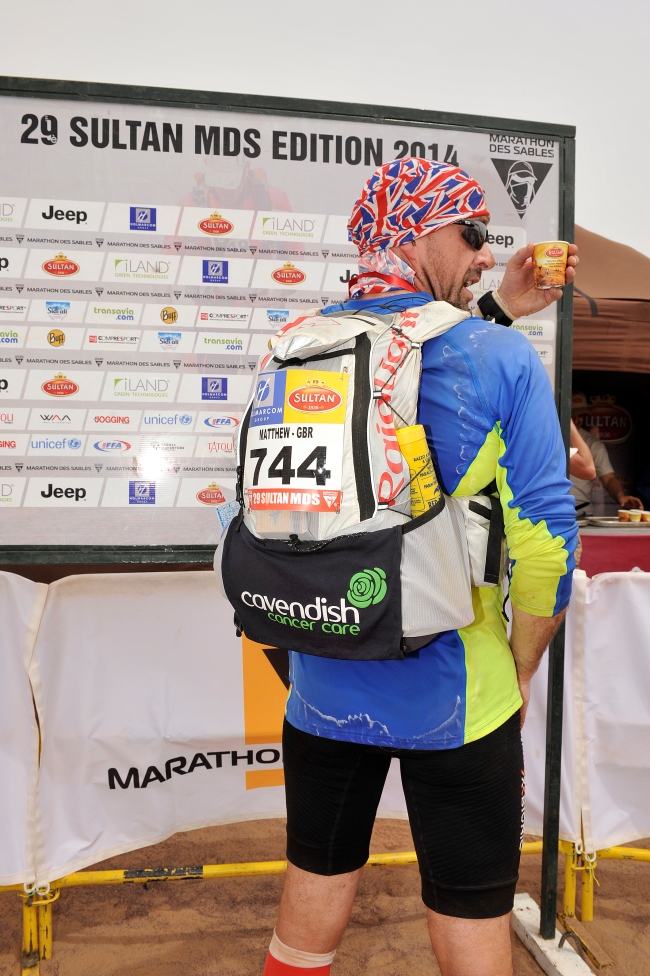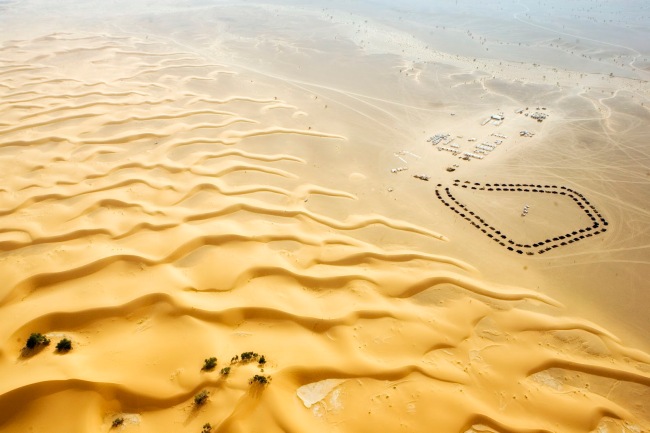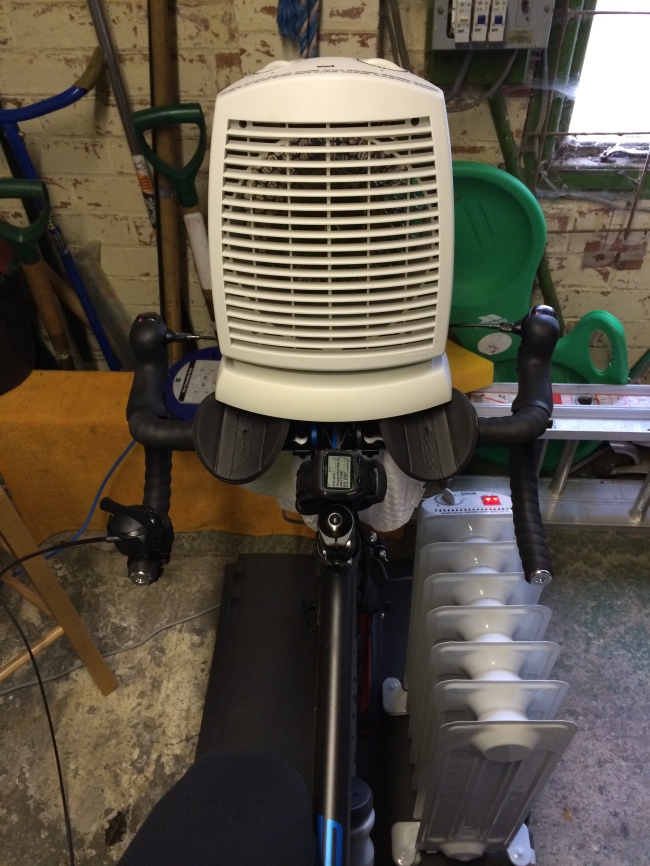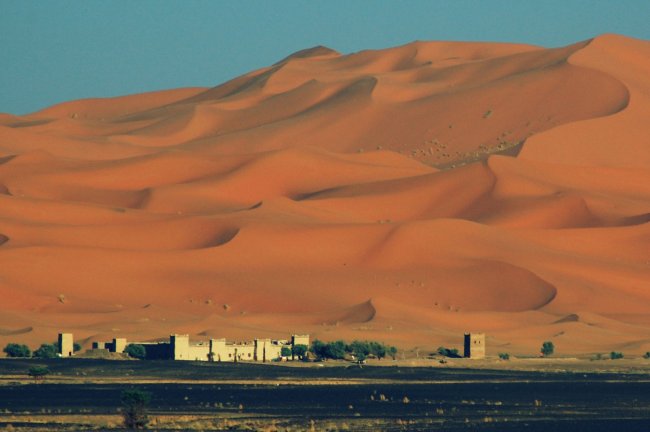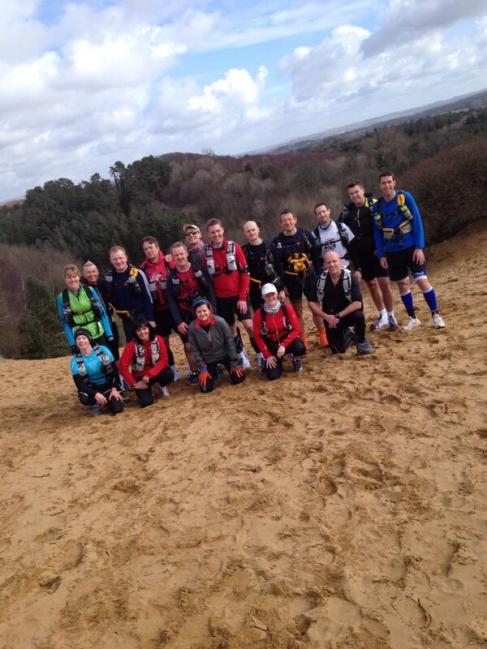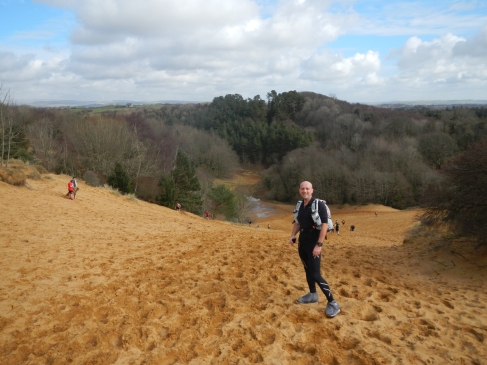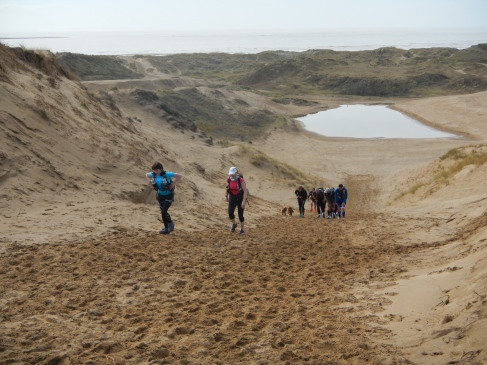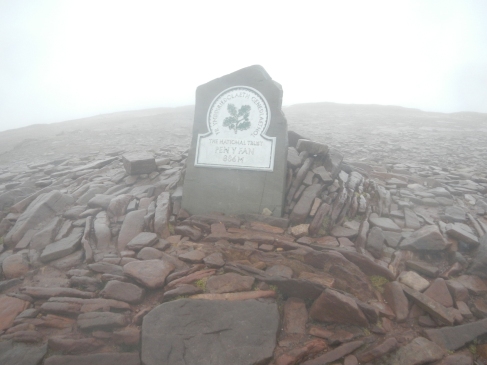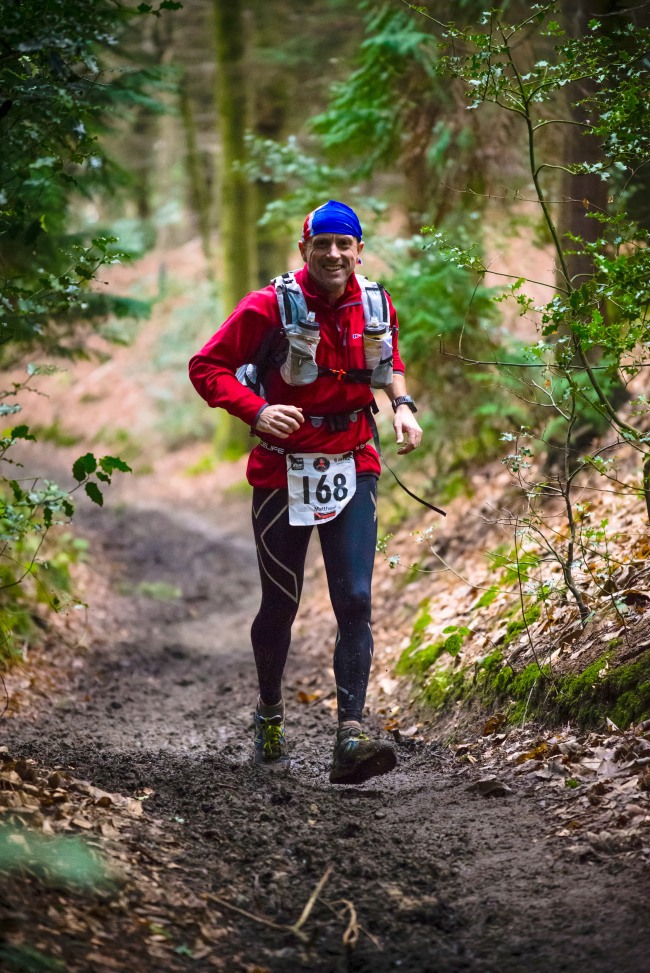Like a frog hibernating through the cold winter, eventually there comes a time to resurface or fossilise.
#Transvulcania15 Images
Its a Hill! Get over it!
Transvulcania 2015 La Palma
The Transvulcania was my dream race ever since I first saw it televised one Saturday morning several years ago. The terrain, the views, the hype, the fiesta type atmosphere and above all the thought “How the hell do they race like that?” I think I had only been running about a year when I first saw it and the idea took root that, one day maybe, I could be there running that ridge above the caldera and rushing down that punishing descent to the red carpet and the crowds and the party atmosphere of the finish in Los Llanos. Well that was the idea…
Training had gone reasonably well since minor injury in the autumn and after my fun in the desert of the #MdS14 in Morocco. Lactate threshold testing courtesy of Stu at Accelerate in Sheffield enabled me to gain both speed and endurance by training within HR zones and hopefully will form a base for further improvements this year. I still wasn’t breaking 19mins for 5k but was reasonably consistent and I had been trying to put in hill training sessions as much as is possible for the relatively flat part of the country that I live in. A couple of traditional fell races gave my legs a good test out on the hills in the couple of months leading up to the Trans and I managed to drop my Half Marathon PB to just over 01:29 on a hilly course at the Sheffield Half. To test out my endurance I also managed a solo unofficial marathon time of 03:35 down from my previous PB of 03:51 so I thought things were going pretty well.
In the week before flying out to La Palma I didn’t feel brilliant but put it down to nerves! Flying out on a Thursday and arriving at the Hotel Princess in Fuencaliente late evening meant that we had to spend the Friday getting up to Los Llanos for registration. That wasn’t too bad as taxi and bus services are pretty good on the island. Registration for this race is pretty smooth and there’s a busy race fair and equipment expo to wander round looking at promos for other races and nice shiny kit. You really get into the swing of things here and seeing the finish line being set up and the red carpet being rolled out whets your appetite for the following day’s challenge.
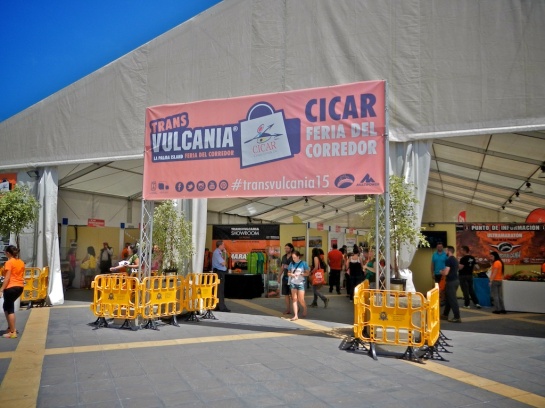

Trouble is I couldn’t really relax and felt overly anxious as I prepped my race kit that evening, taped my feet, fuelled up and tried to get an early night.
The race bus from the hotel to start is all part of the deal but it leaves the Princess at 03:30 to get down to the Lighthouse at the southern tip of the island. The hotel laid on breakfast for the runners from 02:30 which was a nice touch and the restaurant was full of people fuelling up on last minute bananas and nutella before getting to the bus and starting the short trip down the coast to El Faro. You get there by 04:00 and have two hours to wait until the start at 06:00. Those in the know get off the bus and immediately run to find shelter behind the walls around the lighthouse. Why? Well its blowing a gale over the exposed tip of the island and while not exactly a cold wind you soon start to chill off if you don’t find shelter. It results in hundreds of racers for the Ultra and the Half huddled up like refugees eeking out what warmth they can for an hour or more before it gets worth forming up down by the start line.
Spare kit can be left with the bag drop to be taken to the finish so its worth taking a light insulating layer to wear up until maybe 30mins before the start and possibly a sit mat as the hard volcanic rock gets mighty uncomfortable after a while.
Obviously at 06:00 its still a good hour before sun up and the start arena is brightly lit along with everybody’s head torches and floodlights illuminating the start arch. The build up to the start is all rock and roll with frantic spanish commentary from the race MC as the count down clock is projected onto the cliff face above. We are just above sea level and in front of us is 4000m of leg and lung bursting climb to the summit at Los Muchachos before the punishing descent and final climb to the finish. The obligatory AC/DC lyrics kick in with Highway to Hell as the last seconds tick by and we are off. I’m way at the back following advice to avoid the scrum that forms as 1800 runners surge up the roadway, round the lighthouse and converge on a volcanic cinder path barely five feet wide.
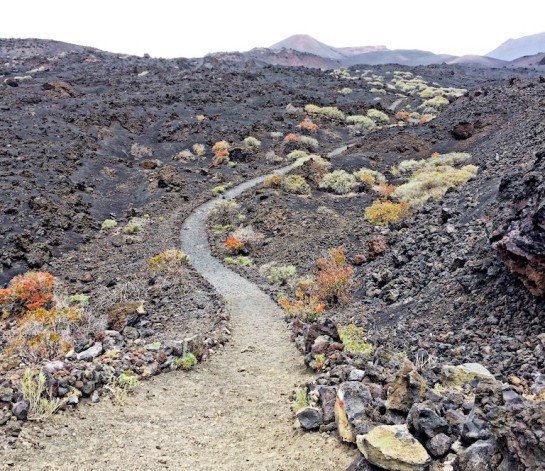
It’s carnage but seeing the head lights of the elite field literally flow up the mountain side is hauntingly beautiful. For mere mortals such as us its soon a crowded walk up soft volcanic dust, jogging where you can and trying desperately to avoid the sharp points of the forest of running poles around us. The course even at this early hour is lined with enthusiastic supporters and the adrenaline rush carries you onwards and upwards at least for the first few kilometres. Before sunrise the route rises up around the base of the Volcán Teneguia and Volcán San Antonio towards Los Canarios and the first check point at only 7.4km but after over 700m of ascent. It took me 01:22 to get to this point and this was well off the pace I had hoped for but with the field settling down I hoped to speed up over the next section. Los Canarios was crowded with supporters and a continuation of the party atmosphere even for those of us in the back half of the pack. I think at this point I was running in about 1000th place!!! The elite pack will have been through over half an hour before. Wave, smile, fill up with water and move onwards and upwards. Always upwards!
The sun comes up over the ridge on the next section and streams through the clouds of volcanic dust kicked up by thousands of feet. We wind up through pine forests and gaze down onto the cloud layer of the temperature inversion.
The climb to Las Deseadas at 18km and 1931m is relentless but spectacular and after all that hard won vertical we turn downhill once more and lose it rapidly on the run in to El Pilar at 26.8km and 1456m.
At least the descent can be mostly done at a run for me and I don’t lose too much more time. The recreation area at El Pilar is the finish for the Half Marathon (which started an hour after us) and also the start point for the Marathon so the area is busy with spectators and the feed station is busy as this is the first food we get on the ultra. Supplies are great with a variety of food including bananas, ham and cheese sandwiches, oranges, cereal bars and gels. Its a bit of a bear pit as people jostle to refuel and unfortunately some runners rudeness and inconsiderate nature comes to the fore, a feature that will continue to be a depressing trait of some competitors for much of the race. The marathon had started here at 09:30 and so the Marathon field was well ahead of me as I came through at 10:22 (+04:22). I would spend much of the next stage keeping my eyes open for Amy who was attempting the Marathon (her first). By now I was looking more at a 15hr pace at best if all went well and so was concentrating on completion rather than anything more impressive.
I was still managing to run the flatter sections and downhills on the stage to El Reventón but the heat was getting to me by now and despite what I thought was adequate hydration, electrolytes and nutrition I was starting to feel really quite rough. My energy levels had dropped dramatically and I was feeling nauseous and dizzy. It certainly shouldn’t have been the altitude at this point as we were at about 1400m for much of this stage.
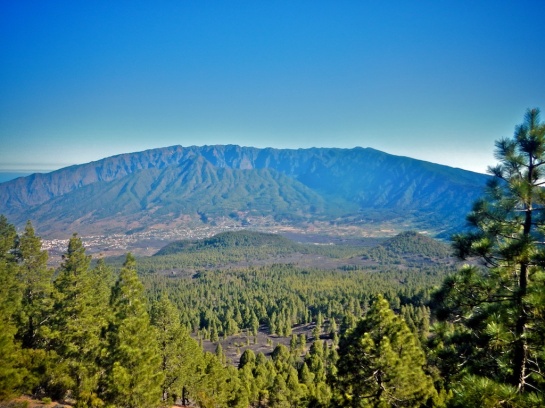
After the check point at El Reventon its up up up! From 1400m at 31.4km to 2351m at 43.5km and the check point at Pico de la Cruz things really start to get hard. I felt like I was going backwards at this point and I was full of negativity. My time was slipping but I was still hoping for maybe a 15:30 finish. There were plenty of people suffering at this point. The emergency personnel were kept busy with people collapsing with heat and dehydration and there were even some helicopter evacuations off the mountain. In retrospect I was coping better than some! By the time I had travelled just over 36k the winner of the race Luis Alberto Hernando was on the red carpet finish approach with a new course record of 06:52:39! Total reality check. It was on this stage on a particularly steep section that I caught up with Amy who was also not having a good time. We were both feeling the heat and despite taking care with fluids and food we were both dizzy and drained. This section also proved to be problematic because of errors in the route description a 4.5km error in the described distance to Pico de la Cruz led to many being short of fluids and the check point just never seemed to appear. Descents were still runnable but the ascents at this point were reduced to a crawl. I was getting severe pain in both little toes to my surprise, probably due to the way I had taped them and it felt like my right heel was blistering, something that has not happened in ages.
The check point at Pico de la Cruz was a mess! Plenty of water and food but it looked like a rubbish heap with discarded cups, orange peels, water melon rind. There was plenty of cola at this aid station at least which went down like a dream. Both Amy and I were determined at this stage to get to the summit at Roque de Los Muchachos before making any further decisions and we pushed on along the ridge of the massive volcanic caldera. The views from here are astounding. I have never seen such massive cliffs and such yawning drops so close to a race route. Not a good place if you get vertigo but breathtaking and awe inspiring if you have time to stop, gaze and take it all in and you should do as it would be criminal to go all that way and not soak your self in the awesome beauty.
You can see the next check point at Los Muchachos across the vast space of the caldera and it never seems to get any closer. The ridge undulates and the path winds round soaring pillars of rock inches away from thousand foot drops. What little shade there is short lived and after each climb yet another descent and further climb appears between you and the distant aid station tents.
The final climb was pure pain and as we collapsed across the check point timing mat we knew really that we were finished. We were very close to the cut off times and I was totally empty. The descent from Los Muchachos, approximately 2500m in 18km is steep by any standards and I was not sure I would make down in time even if my legs held out on the punishing gradient. At this point we made the decision that our races were run and I certainly was in no fit state to continue down to Tazacorte and on up to Los Llanos. Having said that all the aid stations were very well staffed it was almost impossible to work out who was in charge or who to surrender your timing chip to. All the volunteers and officials were in orange Transvulcania shirts and I speak very little (no) spanish. However we managed to find somebody who seemed to be organising stuff rather than just dispensing water and food and they took our chips and directed us to the coach that was to take us back to the finish.
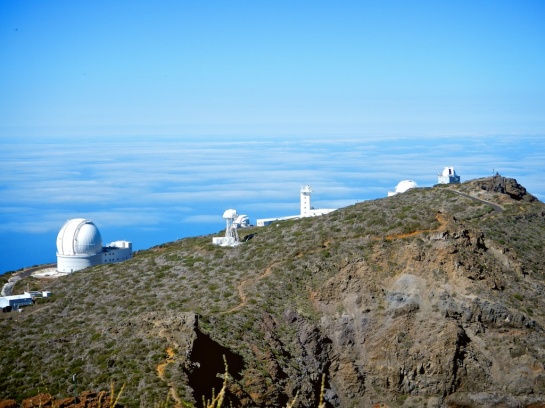
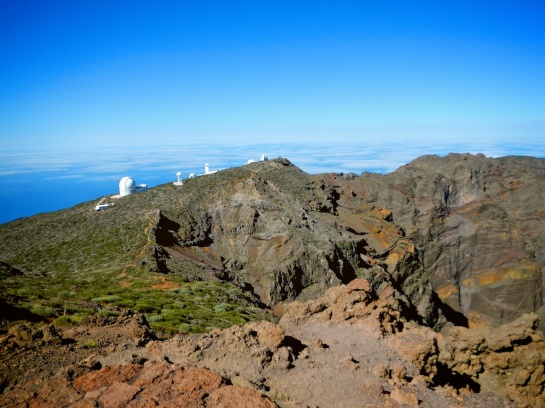
We managed a few more photos from the summit and then wearily trudged down the road to the waiting coach which was rapidly filling up. Soon after, the check point was officially closed and all subsequent arrivals were timed out much to the disgust of one or two very vocal but obviously quite slow competitors.
Having made the decision to withdraw you soon wonder if you should have carried on but I was happy that I had made the right choice. I felt the descent was likely to be too slow and likely result in injury which might affect the whole of the rest of the season. Choice made! Deal with it!
The coach ride back to Los Llanos was surreal. Two and half hours of alpine tight hairpin bends in a 52 seater luxury coach with regular stops for several passengers to get off and throw up. Dehydration, heat stroke or just the motion of the bus I don’t know but there were some pretty miserable looking folk around. One guy behind us managed not to delay the bus by getting off to hurl and just sat quietly puking into his Salomon hydration bladder. They certainly don’t show you that in the Salomon ads!
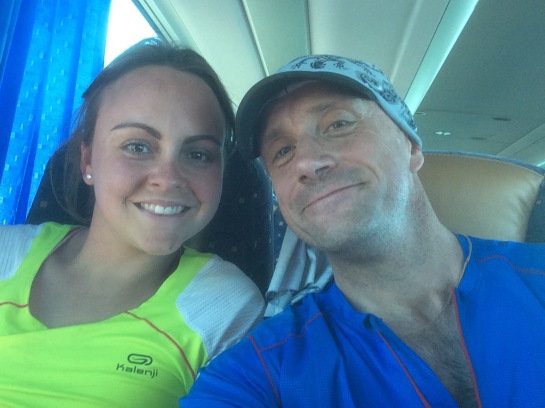
Approaching Los Llanos the coach was held up (understandably) as runners were crossing the road on the final rather brutal looking ascent out of the canyon/river bed at Tazacorte up to the final tarmac run in to the finish. They would still be streaming in to Los Llanos for some time to come after struggling up that last 350m of ascent. After being dropped off we walked up past the finish line red carpet. The finish area looks great with its timing arch and the competitors area is kept separate from the public so runners can get food, drink, massage and medical attention if required. Obviously we were no longer part of that and made our way round to collect our drop bags and find a taxi home. Food, rest and reflection was what was needed, wounds needed to be licked and I had to think what this meant for the rest of my running plans this year.
The Transvulcania was fantastic. Its beautiful and brutal in equal measure and certainly not to be underestimated. I met many good runners with impressive events behind them who almost ground to a halt on that big hill so no shame for finding it hard. What would I do different? Well hopefully I would go into it with a slightly better state of mind! Lots of reasons for that but that’s another story. But on a more practical side? Train on hills, lots of hills! I would take poles, I’m not a great fan but I think they probably help a lot for mere mortals if you know how to use them but just pay attention to pole etiquette and not annoy other runners with your rogue spears. The heat was a factor with it probably reaching 35°C at times and I had done no heat training this year which I did do for the MdS in 2014. Certainly some sauna sessions may have been useful. I didn’t feel nutrition was an issue but I probably needed to eat more. Otherwise my kit was perfect really (Kit list below) and I didn’t suffer any significant ill effects from the sun. I’ve already decided to come back and kick this one in 2017 and I will train hard for it.
From the Fuencaliente lighthouse to the El Pilar picnic and camping site → 26, 8 km.
From El Pilar to Roque de Los Muchachos → 31 km.
From Roque de Los Muchachos to Puerto de Tazacorte → 19,8 km.
From Puerto de Tazacorte to Los Llanos de Aridane → 5,7 km.
Official Transvulcania 15 film: You’ve got to watch this…
Equipment List:
Coming soon…
Time to get serious again? Well, maybe after Christmas!
It seems ages since I last blogged on here but that’s because actually it is! My last entry was in April after I had come back from Morocco and the wonderful circus that was the Marathon des Sables. A lot has happened since then but I haven’t had the most prolific year from the running point of view. Work and moving house has made for a relatively low intensity training schedule and when I did want to up the rate I succumbed to a calf injury in September that took me out totally for about a month. This meant I missed a couple of races that I had been looking forward to. The first was the Nine Edges Trail Race in Derbyshire along the Gritstone Edges which I have now entered twice yet not run either time! Hopefully third time lucky next year. The other race I missed was the 3×3000 80k trail race around ScaFell, Helvellyn and Skiddaw in the British Lake District. I had recce’d the first two thirds of the route the week before I got injured and it was going to be a brutal but beautiful race. The actual race was held in awful conditions and my friends who actually made the start line had an interesting time of it.
The summer had been a much better time and I managed a few race outings. My first significant race after the MdS was The Wall (RatRace), a run from Carlisle to Newcastle (69 miles). I hadn’t really trained for this one and it really showed with me spending a good proportion of the route walking. There was far too much road in this race for my liking but it was a good event all the same and I managed to run hard for the last 10 miles to finish in 14hrs 37mins. I don’t think I’d do this one again even with training as it wasn’t really my type of route. I definitely prefer a real trail race.
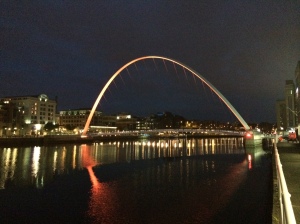
A real trail race was what I got for my next outing. The Ti Dodo Trail 25k race was a fantastic race on the tropical island of Mauritius in the Indian Ocean. One of a series of races (50k, 25k & 10K) the Ti Dodo Trail was 25k of steep technical trails at the south end of the island giving absolutely stunning views over the mountainous terrain. I had thought about doing the 50k originally but for me the 25k with 1500m of ascent was a better choice on no specific training and I felt I did pretty well finishing in 03:46:04 and coming 48th/253. Half way round the course I was passed by Ricky Lightfoot on a fast technical downhill section as he powered on to win the 50k Dodo Ultra in record time. Awesome performance and quite inspiring.

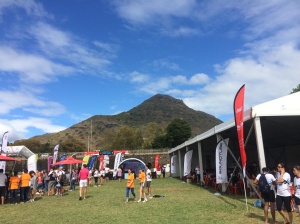
My downfall for the tail end of the summer came when running in a local 12k trail race in the forests behind our village. I was having a good race with a respectable position for a non-club runner and had been making up places along the trail. I was gearing up for a final push with less than 500m to go when I pulled a calf muscle and had to hobble to the finish line losing five or six places on the way. I’ll definitely be going back to sort that one out next year! The injury was sufficient to lay me low for the best part of a month but i think I was sensible enough to rest it properly and managed to start a slow but steady return to distance and speed once the pain had settled.
So since then I’ve been gradually increasing the distance and I’m back up to comfortable 25k distances and even the speed work on the treadmill has been paying dividends with some good pace out on my fast training runs and a return to sub 20 min 5k for trail ParkRuns down at Clumber Park (PB 19:08 pre MdS and my most recent 19:33). I’ve been trying to get out with Danum Harriers in Doncaster recently but as always a regular club night never seems to fit in with my rather irregular lifestyle. They’re a good bunch and a really enthusiastic club and I look forward to joining up and racing with them when I can.
The MdS made easy! How to survive in the desert.
Preparation: What was good?
I worked hard for this one! I had been training for almost two years but the training only became serious with about nine months to go to the race. The physical training was one thing, putting in the miles and increasing my strength in the gym was essential and having a plan to work to from Rory Coleman certainly helped a lot. I lost weight by minor alterations to my diet and limiting my carbohydrate intake for about five months prior to the race, dropping from approximately 82.5kg down to 74.5kg by race start. This made a massive difference to me and was evidenced by me improving my 10k and 5k times significantly alongside my endurance training. Make sure you have actually run an Ultra before, preferably a multi-day stage race and preferably with a long day thrown in. I had done the Ring of Fire in Wales (134km, 3 days) and the Pilgrim Challenge in Surrey (66 miles, 2 days) in the run up to the MdS and the long day of the RoF (66 miles) was perfect preparation for the long day in Morocco. You will spend a lot of time walking unless you are of the Elite so the advice to me was spend time learning to walk over many hours. Time on your feet is actually worth more than km run.
I’ll go into my kit choices later but I was trying to keep my bag down to the magic 6.5kg. As it was I only managed 8kg at weigh in but that was a lot lighter than many. A light pack is a joy to run with! A heavy one is torture!
Foot preparation was I think a massive element as the state of your feet can make or break a race like the MdS. Basic Chiropody is easy, keeping your nails short and well filed back reduces nail associated blistering and the shear forces that can be caused by the nails catching on socks and shoes. This in turn reduces the chance of losing those nails to bruising. There is a lot talked about preparing the skin of your feet with all sorts of preparations. I just used NOK which moisturises and protects the skin. The skin remains supple but tough and the NOK can also be used as a skin lube if needed. I use it on my feet anyway but I used it daily for a month prior to the race. I also tape all my toes for long ultras with Hapla Band tape on top of Tincture of Bezoin as an adhesive. My taping for this race stayed intact until I reached the hotel at the end and I had only one small blister on the side of my big toe under the tape which then needed no attention as it seemed to re-absorb whiteout issue. Other than that I has one small blister on my heal which responded well to secondary taping of the whole heal and caused no more problems. Air drying your feet at the end of each days racing is essential and attending to minor issues before they become major ones is time well spent. Shoes obviously are important too! Mine were Brookes Adrenaline GTS(14) in a 2E fitting. My normal size but the 2E fitting allows for a more comfortable fit. My feet did swell at times (as did my fingers) but they didn’t get appreciably longer so all the talk about getting a size or two bigger than normal is a little suspect. Bear in mind that those who do recommend a size or two larger are probably referring to european sizes and not UK sizing, there is a big difference!!
Camp Life:
Routine in the Bivouac is important and sorting out your routine admin in the tent once you get back each day goes a long way to making sure you are prepped for the next stage. Once you get across the line each day pick up your water ration and get back to your tent. Lie down and get your shoes and socks off to allow your feet to dry in the air. Clean them with a little water and a wemi wipe or similar, clean feet are healthy feet. Sort out any blisters or problem areas if you can. Get yourself a recovery shake if you use them. I had a SiS REGO shake at the end of each day and it was a wonderful way of getting carbs and protein in fast to start your recovery. That was then usually followed by a Peperami. Peperami is one of the few foods that actually tastes better when allowed to warm up in your pack in the sun all day! At this point you then need to decide if your feet need further attention from Doc Trotters the camp medics and get over to their tent sooner rather than later to avoid the queues. Luckily I never needed to visit Doc Trotters but many did! If you can get your salt stiffened running kit off and get something more comfortable on then do it. You can rinse your running kit out quite easily in water bottle, its not washing it but it does freshen your kit up ready for the next day which can make all the difference.
Camp hygiene is really important and the MdS organisers have made great strides to make the toilet facilities as good as possible. The “poo bags” system seems to work really well but you still need to pay attention to your personal cleanliness. Its amazing how you can have a good total body wash down with a couple of WemmiWipes and a little water and making sure you use hand sanitiser before sorting your food is essential if you want to reduce the likelihood of gut upsets that could ruin your race. The “No handshakes or high fives” rule is a good one! You don’t know where everybody else’s hands have been!
There’s not much else to do now except get your main meal sorted and settle down to rest. A hot meal and a bit of a treat is a great way to celebrate your days achievements and give your body the fuel it so desperately needs. You need to eat even if you don’t feel like it so make sure you have palatable food that goes down easily. If you want to spend the whole evening socialising around the bivouac then fine but rest and recovery is what you need if you aren’t going to crash spectacularly later.
Each morning the routine is similar. Get breakfast, get your water ration, get your running kit on, pack up your bag and sort out your snacks, gels, bars or whatever and get ready to run. Start replacing/supplementing your electrolytes early and take your salt tablets with your morning drinks, you don’t want to leave it until you are already salt deplete before you start because you will never catch up! Whatever happens by the end of the race you will be sick of drinking bath temperature water flavoured with whatever electrolyte tabs you use! I used NUUN tabs in each of my 800ml Raidlight water bottles. They are great and work very well (make sure you take a variety of flavours) but by day four I never wanted to see another NUUN tab as long as I lived.
En route I drank my water every 15 mins religiously and at each check point I took my salt tablets as directed. The race crew are constantly reminding you about your salt tabs and its best to do as you are directed. You do not want to crash out of the race for want of a bit of salt. Do as you are advised!
Equipment:
Equipment can be expensive but doesn’t need to be all the time. There is a lot of stuff sold specifically for the MdS with a price tag to match but much of your kit can be sourced more cheaply, shop around on-line and don’t leave it until the last minute to get your kit sorted. Having said that your kit is a very personal thing and you need to get what is going to work for you. Advice given to me was don’t take stuff “just in case”, on the rare occasion you find you need something that you haven’t got then you can guarantee somebody else has what you need! My main kit list is below, it all worked well for me but I could have probably saved a few grams here and there if I’d really tried:
- Back Pack: Raidlight OLMO Ultralight 20L. Not the most robust of bags but pretty light and has all the room you need.
- Sleeping Bag: Yeti Passion One. Rather expensive down bag but very compact and did the job for me very well.
- Sleeping Mat: ThermaRest Prolite Plus XS. Light weight and very comfortable but you need to put your feet on your bag or similar as the stoney ground is very hard.
- Pillow: Mammut Inflatable. Fits conveniently inside the hood of your sleeping bad (Otherwise they blow away!!) Not absolutely necessary as you can just roll up your running kit or rest your head on your shoes! You decide.
- Cooking: Esbit ST11.5-TI Titanium Stove and Titan Titanium pan (As I only had hot food in the evening I only used one box of fuel (20 Tabs)) Long handled plastic spoon at 9g.
- Sun Glasses: Sunwise Windrush (Also had a pair of SunDog Goggles for sandstorms but didn’t need them!)
- Hat: Buff Visor UV. This is just perfect, light, comfortable and excellent when wet to cool the head. I also had two other standard Buffs with me to protect my neck and for sand protection.
- Running Top: Under Armour Heatgear, Flyweight Run Long Sleeve Tee. Absolutely brilliant lightweight top with high SPF.
- Running Shorts: X-Bionic Running Pants, light compression and loads of other features and claims. Make your own mind up about those but they were supremely comfortable for me.
- Socks: Injinji Original Weight Crew Length. Two pairs, fresh sock for the long day is a good move.
- Underwear: Kalenji Essential Briefs from Decathlon (2 pairs). Comfortable, wicking and easy to rinse out and dry. Most of all they’re cheap!
- Shoes: Brooks Adrenaline GTS (2E)
- Gaiters: RaceKit. These are great and do the job very well although damage due to rock strike can let a surprising amount of sand in through a very small hole. Don’t expect them to last for more than one race though! The best place for getting your velcro stitched to your shoes to secure your gaiters is the “Shoe Healer” in Doncaster.
- Compressport Calf Compression: Use at least one size bigger than sizing charts would suggest. Compression is great but as dust still gets through them and mixes with the sweat you do sometimes get a heat rash type reaction which caused some people a degree of discomfort.
- GPS/Watch: Garmin Foretrex 401. Excellent GPS to keep track of the K’s as you run and has the added advantage of taking 2x AAA batteries (I use Energiser Lithium Ultra lasting about 22 hours).
- Night clothes: Skins A200 Leggings and an ODLO L/S Crew Neck Evolution Light shirt. Generally good mild compression and excellent for recovery. A little warm in the early evening but by 2am you really appreciate the extra insulation. Real light weight runners will just sleep in their running kit but its good to put something different on at night as far as I’m concerned. Many wore Tyvek suits but I heard varying reports for those and my night stuff could double up for running if absolutely required. The top and leggings came to just under 300g. Also no need for a sleeping bag liner.
- Sun Cream: Tingerlaat 20ml, SPF50 (If wearing long sleeves and only knees exposed you only need one small tube!)
- Hand Sanitiser: “No-Germs” 25ml (About 200 sprays from one pack, more than enough)
- Toilet Tissue: Handy Pack Tissues x3
- Wash Kit: WemmiWipes 24 tabs (removed from their tubes), Boots Cleansing Handy Wipes (12 Pack), Small 20g Tooth Paste, Cut down Travel tooth brush.
- First Aid Kit: 16x Paracetamol, 10x Co-Dydromol or similar (Help you sleep as well as analgesia), Immodium Instants, Antihistamine of your choice if needed.
- Foot Care Kit: Hapla-Band 2.5cm, Tincture of Benzoin in small spray bottle (Scissors/Blade/Nail File see below)
- IKEA Slippers: Not as good as I hoped but intended for use around the bivouac when you don’t want your trainers on. I must admit I ditched them after the first three days!
Essential Kit: As specified by the Race Organisers.
- Knife: Victorianox Classic SD, has a good sharp blade, fantastic small scissors and a nail file/screwdriver blade.
- Topical Antiseptic: Tincture of Iodine (Alcohol)in small spray bottle.
- Emergency Blanket: Cut a standard one in half. If you need a full size one the medical tent will provide at point of need.
- Venom Pump: Got to take but nigh on useless on this race. Take the smallest adapter and ditch the carry case.
- Compass: Silva Field Compass 2 degree precision. You can go lighter but if you actually had to use the compass then this is the best option. If you don’t know how to use a compass then it doesn’t matter what you take so a lighter less accurate one is fine. If you get lost a compass doesn’t really help!
- Head Torch: Petzl MYO RXP with 3xAA Lithium Ultra Batteries
- Signalling Mirror: I took a freebie rectangular CD as I couldn’t be bothered to buy a plastic mirror for £5!!! Anything highly reflective will do!
- €200: Single 200 Euro note is the lightest at 2g!!
Luxuries:
- iPOD Shuffle: Essential for those dark times when you need a lift. Only 15hrs worth so save it for when you really need it!
- Mint Chewing Gum: Great for clearing the head and giving you a little boost. Weighs next to nothing for one pack.
Food and Nutrition:
Try all your food before you go out! This is important as you do not want to find your choices are not to your liking at the start of the race. Your tastes change under stress and your ability to exist on the food you take should be tested out under exercise conditions if at all possible. You will crave salty food more than you can imagine and the sweet stuff will take second place. Be aware that dehydrated meals that claim very high calorie content ~800kcal will only provide that much energy if you can actually eat the whole meal! If you lose the taste for it half way down the bag you will be hard pressed to finish it. Flavour and palatability is probably more important that absolute “kcal” count. The ruling on a minimum of 2000kcal per day causes so much angst amongst people new to the MdS. My main food bag for each day came in at about 2050kcal per day but I also had REGO recovery shakes and QNT Energy gels on top of that as there was confusion as to whether these counted towards the calorie count.
My daily rations looked something like this:
- Breakfast: 25g Macadamia nuts, 25g Pine Kernals, 25g Dried Cranberries. Altogether ~424kcal.
- Peperami: 126kcal of salty meaty heaven!
- Chia Charge Flapjack: 357kcal
- Chia Charge Trail Mix: 160kcal
- Coconut Bar: 244kcal
- 25g Salted Peanuts: 155kcal
- Real Turmat Freeze Dried Meal: Approx 600kcal depending on meal.
- SiS REGO Rapid Recovery Shake: 184kcal
- QNT Gel: 279kcal
Absolute daily menu composition varied a little but I found this gave me the right combination of sweet and salt and certainly kept me going. The “Real Turmat” freeze dried meals were a real find, recommended to me by my friend Archie. They are a Norwegian brand and are quite expensive at approximately £10 each but for flavour they can not be beaten and I looked forward to them every day. I decanted the contents into Soup ‘N’ Sauce bags to save space prior to flying out and these bags worked perfectly for reconstitution and as a container to eat from. Each days rations were then bagged up to provide ease of packing and access.
The snacks I ate en-route tended to be the Coconut Bar, Chia Charge Trail Mix, Salted Peanuts and the QNT Gels. The caffeine in the gels certainly helped to kick me out of the low points of the day and the fact that the QNT gels have a screw top means you can sip from them slowly over the stage to keep a steady supply of carbs and caffeine with no sticky fingers.
Thats about all I can think of for now so I’ll post this and update it later if I think of anything else. Any questions? Feel free to ask me direct.
Once more out of the desert my friend…
I’m ravenous! I’ve done nothing but eat for over a week now and I haven’t put on any weight! And I’m missing the desert…
Its over a week now since we finished the 29th Marathon des Sables and I feel blessed. I have feet that work, legs that work, I’m not having nightmares and flashbacks and I’ve even been out for a couple of pretty fast runs since getting back. Compare that with some of the folk who did the same race in the same conditions and you might agree that yes, I am blessed! Some are still hobbling and are only just getting round to being able to put on shoes because of their swollen, blistered and mashed feet. Some are dreaming of still being in the middle of the long day and wake panicking that they can’t find their running shoes or gaiters. But for me, I feel calm, comfortable, cleansed and grateful for having had such a wonderful experience. The fact that I managed to raise a little money for Cavendish Cancer Care is just icing on the cake!
The MdS has been called the “Toughest Footrace on Earth”(predictably by a TV company)! It is not the toughest by any means but it is tough enough and for the majority of entrants it will be the toughest thing they ever do and they should be rightly proud of stepping up to the line never mind finishing it. The combination of heat, duration, water management, nutritional depletion, wear and tear to the feet and the relentless soul sapping sand underfoot conspire to chip away at the best prepared athlete and the fact that so many ordinary people find the reserves to drag themselves to the finish is testament to their inner strength. The 2014 Edition, the 29th MdS, was hard! Most people who have been there before agree that it was one of the hardest, not due to heat or distance (that is a given) but to the percentage of the course run on soft sand and in the dunes. Out of the record breaking field of 1029 at the start of the first day, over 100 fell by the wayside for various reasons despite herculean efforts and this was the highest retirement rate for many years.
I’m not going to give a blow by blow of the stages of the race as there are far better blogs than mine that give a good feel for the race but there are some aspects that need exploring. The overall organisation of the MdS is phenomenal. It is a massive circus complete with the grand ring master Patrick whose vision and drive makes this event come alive and stalk it’s way across the desert. The Bivouac is huge. 147 Berber tents of eight competitors arranged in concentric rings. These are your home and destination though out the week of the race and the place of safety you retire to at the end of the many hours you spend in battle with the sand. Each morning as you prepare to race, your tent is collapsed and spirited away by the Berbers leaving a bare field of what appear to be refugees, packing their worldly goods into their backpacks prior to toeing the line once more. All these tents are then spirited away along with all the tents of the administration, medical staff, communications etc and magically re-erected at the next bivouac in time for your arrival later that day. The organisation is slick, professional and slightly mystifying!
Your tent is your home and your tent mates your family for the duration of the race. Same tent, same people, same place in the bivouac, same neighbours. Your tent mates, who you may only know vaguely or not at all before the race rapidly become family and in sharing such a life changing event are likely to become lifelong friends. My tent was “126”, Archie, Mick, Steve, Wayne, Ian, Peej(John), Steve and myself! A eclectic mix of characters and abilities but one that almost instantly gelled as we looked out for each other during the stages and in the bivouac, celebrating each others successes and high points and helping each other through the dark periods and low points. All eight of our tent completed the race and whether you were first back in the tent each day or last one back the greeting and support from your tent mates buoyed you up massively. Some of us arrived back each day with torrents of expletives about the conditions before settling down to our tent life routine while others arrived back with a smile and an air of fortitude after hours in the sun and sand that humbled us and centred us ready for the next day.
My race was as good as it could have been and I’m happy with my overall place. I wish I had been able to run more in the first three days but after day one the heat reduced me to fast route marching for the majority. The first three days were 34k, 41k, 37k and day one started with 12k of the biggest dunes in Morocco. This was meant to set the scene and reaffirm the fact that this is a tough race. No gradual easing in to the desert, just bang, straight in, massive dunes in searing heat. This is where many fell by the wayside and where many others were reduced and weakened for the days ahead. I managed to run much of the first day and finished in 301st place but for days 2 and 3 I was reduced to grinding out the distance with my head down, full on Ultra walk! I finished in 422nd place and at the end of day three I finished in 371st. The long day 81k went really well but was done at route march speed. After the first flat stage to CP01 everybody’s speed dropped off dramatically as the long slow queue to climb a monster Jebel resulted in about 1.5km travelled in over 90 minutes.
I spent the whole day with Wayne Drinkwater as we encouraged each other through stage after stage. Each of us having bad periods where the encouragement from the other was the only thing that kept us going. Long flat salt pans and dry lake beds allowed reasonable speed but another beautiful but exhausting climb up a Jebel beyond CP03 slowed progress and was followed by a long section of deep soft sand. Almost everybody was out of water before hitting CP04 and the rest tents were crowded with people refuelling, resting and trying to recover before starting the long straight drag to CP05. The sun set on us on this long section and the amazing sight of the bright green LASER projected from CP05 as a homing beacon arced across the clear skies.
Each check point required us to rest and regroup, concentrating on getting adequate calories in to ensure we could make the next and having some time horizontal resting the legs and minimising the swelling of our feet. We were exhausted but there were plenty around us who were in far worse states, needing to rest for several hours in their sleeping bags and being tended to where necessary by the medics at each check point. Resting for too long was not an option for us as it would become increasingly difficult to get going each time so we would get up and grind on as soon as we could. The last two sections on to CP06 and then on to the finish seemed to be never ending. The soft sand was relentless and exhaustion meant that there was nothing to do but go all out, walking as fast as possible, counting off the glow stick markers as they were passed. The bivouac appeared in the distance but never seemed to get any closer. It was a feature of the route on all days that the bivouac was visible from many km out and those k’s seemed to become longer and longer almost as if the bivouac was a mirage. Wayne and I crossed the line on the long day together in 16H30min and 380th position which was actually faster than I had anticipated and testimony to what you can do even when walking.
The rest of that day (Day 5) is technically a rest day if you are lucky enough to finish during the night and then get some sleep. Getting into the sleeping bag by 2am was bliss but even so I was awake by 6am, glad though that I didn’t then need to get prepped and up for another days racing. We had four of our tent in by now and the rest appeared gradually over the next three hours or so. All had survived the long hours of darkness. Rest, recovery and recuperation were the order of the day and the treat of a cold can of full fat Coca Cola was very welcome that afternoon.
No matter what some people say, that one can of Coke was pure heaven. Racers were coming in constantly throughout the day and as the 34 hour time limit for the stage approached that afternoon the last competitors crossed the line after being out on the course for over 32 hours. Almost the whole bivouac turned out to welcome them across the line closely followed by the two camels and their minders who acted as the back markers bringing up the rear.
The final competitive day, a mere 42.2km stage, dawned slightly cooler than the rest and I was feeling good. I had promised myself that I would just run according to how I felt that day and as we started I felt strong and just let my legs do what they wanted. I had a good day, running the vast majority of the course and the CP’s came and went quickly. The top two hundred racers were starting 90 mins behind the main pack and so it felt strange to be relatively near the front of the pack. There was plenty of soft sand to slow us down but the end was in sight and my legs felt good. I crossed the line in 5H14min in 178th place and knelt and kissed the sand before being presented with my medal by Patrick and then wandering elated back to the tent. I was first back to the tent that day and for about half an hour I had the place to myself until the tent mates gradually started drifting back. We all survived that final day and for the most part we sat around slightly stunned with our success. The race was over and we only had the Solidarity (Charity) Stage to negotiate the following day. Just 7.7k to walk to the coaches and then a four hour ride to Ouazazatte and a real bed and a shower and beer!
Thus started the period of intense eating and calorie re-loading which seems to be ongoing! I’ve spent most of this week thinking about what went right with this particular trip to the desert which made it such a personal success! It was most definitely a success as far as I’m concerned with my final position being 326th in just over 41H30mins which puts me into the top third which was my original aim. More importantly as I wrote earlier I also escaped relatively unscathed and in good physical and mental condition to carry on with my running and racing.
The MdS was a wonderful experience but I doubt I would do it again. There are so many other great experiences to go for and I’m unlikely to be able to repeat this one with a better result. Having said this, I would not have missed it for the world. The Bivouac Buddies of Tent126 made the whole experience a joy and hopefully will remain friends for a very long time. As life experiences go the MdS is up there at the top of the list.
The Final Countdown!
Only two days to go now until we fly from Gatwick to Errachidia and then on by coach to Merzouga below the famous dunes of Erg Chebbi. Its all rather real now and I have to admit I’m nervous. The spectre of my trip to Egypt last year is still in the back of my mind but this year I am fitter, lighter and more mentally prepared than for anything I have ever attempted before. The last minute obsessive packing and repacking of the all important kit paring down the weight gram by precious gram seems to be a nationwide psychosis amongst all the competitors I know but at least my kit appears to be a lot lighter than some but not as light as I’d like. I can’t wait to actually get on the road now as the last couple of weeks of reduced activity and a long week at work have wound me up to the point of mild craziness. So many people have been training in heat chambers in full kit and I just haven’t. I’ve sat in a few saunas just to get my body used to the heat and my turbo trainer I rigged with a couple of heaters to up the stress but nothing formal. It will be interesting to see how the heat treatment works for those who have put the time in on a treadmill in the oven.
My fund raining for the Cavendish Centre has been going well (http://uk.virginmoneygiving.com) and I should have got over £800 (including Gift Aid) by the time I finish. People have been extremely generous and for that I thank them.
At some point I will post a kit list of what I finally took to Morocco along with the pros and cons if anybody is interested. The whole process of kit selection is a hurdle almost as big as the physical training and is not to be underestimated and there is a massive amount of rubbish that is spouted from various sources and also many many gems of wisdom that hopefully will make the race more enjoyable. The post race distillation will hopefully make things clearer. Its been a long journey to this point and I’ve met some fantastic people and I’m sure will meet many more over the next few days. Time to bring on the red sand, the blue skies and the purifying pain of determination. Allons-y!
Putting all the effort to good use.
The MdS has been my focus for some long time now and I have trained hard to try and make this adventure a reality and maximise my chances of success in the Moroccan desert. It’s now less than 30 days until we fly out and my head is in the right place, and if my head is right the body should follow. Doing this run is a personal challenge and that is my first concern but it seems a shame not to put the effort to some good use beyond my own mid-life craziness. To that end I will be asking for people to consider sponsoring me in raising money for the “Cavendish Centre” in Sheffield.
Less than a month to go now and I can’t wait to get started.
“Cavendish Cancer Care is a local Sheffield charity dedicated to improving the quality of life for people living with cancer in South Yorkshire and North Derbyshire. We believe no one should face cancer alone, so we provide emotional support through counselling and complementary therapies. Our services are provided free of charge and we rely on the donations from supporters and help from volunteers to continue our work.” http://www.cavcare.org.ukI’ll be putting a Virgin Giving page together for any on-line donations at http://uk.virginmoneygiving.com/MatthewNeal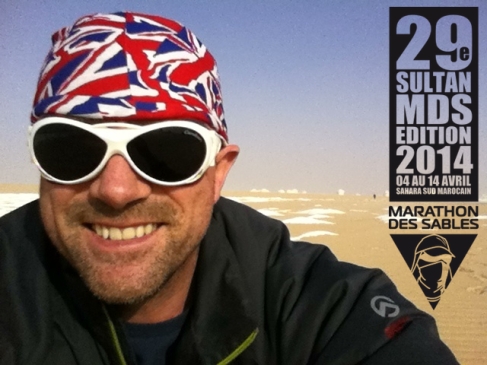
Thank you all in advance…
South Wales MdS Training weekend
Where did the last four months go to?
Its the end of February and I haven’t posted anything since my rather abortive effort at the Mablethorpe Marathon in October. All of a sudden it’s only five weeks until the MdS and life is getting really serious. The last four months have actually been very productive in many ways and my training has been going well. I’ve lost about a stone in weight and I’ve been following one of Rory Coleman’s training schemes to get me sorted for Morocco. I’m on track and my mind is obsessed with sorting food for the race and cutting down the weight of every bit of equipment I can.
So what has been happening since October? Apart from training as hard as work allows and trying to stick to my pre-race diet I have done some events. To break up the monotony of just running I did the Spartan Beast in November, 18 miles of freezing cold mud and total immersion water sections interspersed with man made obstacles involving weights and plenty of ice. Sheer torture and I can’t remember ever being so cold, at least not away from the mountains. It was hard work but made definitely more bearable by doing the race with a friend and the constant mutual support that provides. Some people don’t think these kinds of events are serious sports or endurance but believe me you don’t know until you’ve been there!!
Once I got back to training properly I managed even to put in a bit of speed work. I ran the Edwinstowe Trail 10k in December and managed a personal best 10k of 42:17 even though it was a trail run and I managed a new PB 5k at a rather muddy Doncaster ParkRun with 20:10. Since then it has been back to longer runs and apart from a couple of weeks with the obligatory cold and sniffles over winter things have gone well. My last big event was the XNRG Pilgrim Ultra at the start of February. 66 miles (2 x 33 miles) of the North Downs Way in Surrey over two days.
Wonderful weather but terribly muddy underfoot and the course was diverted due to flooding at at least two sections. Good preparation for multi-day running in Morocco if not for the weather conditions. A good taster of the incredibly well organised XNRG event can be found in the following video.
This weekend I’m off down to Cardiff for another MdS training session with Rory Coleman in the South Wales sand dunes and up on Pen-Y-Fan for some hill work. The last time I was down running in the dunes was a real eye opener.
I’ll post more when I get back…





































